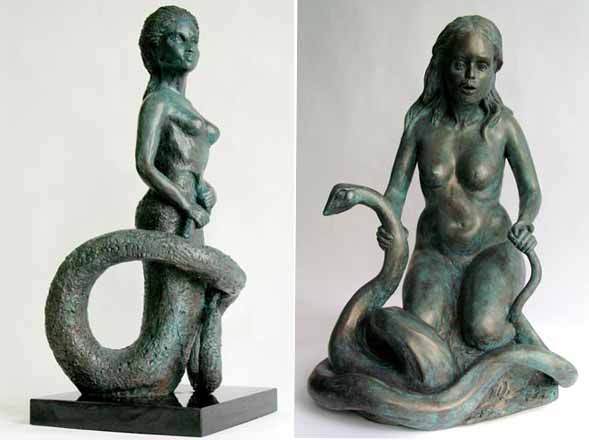Snakes in the Psyche III
From the website of Maria Taveras, a Jungian analyst and artist
Jung also discusses a case in which a snake emerged from the mouth of a woman. After World War I, a 28-year-old woman consulted Jung. She wanted “to be cured within ten hours” – that is, within only ten analytic sessions. The woman told Jung that “she had a black serpent in her belly.” That was the reason the woman had consulted him, “for she thought that it should be awakened” (1996: 84). The woman was “only intuitive, entirely without a sense of reality.” Then she announced that the snake, which had been dormant, had suddenly become active. “One day she came and said that the serpent in her belly had moved; it had turned around,” Jung says. “Then the serpent moved slowly upward, coming finally out of her mouth, and she saw that the head was golden” (1996: 85).
In another account of the same case, Jung mentions “a young woman about 27 or 28” who informed him during her initial analytic session that she had a snake in her belly: “Her first words were when I had seated her, ‘You know, doctor, I come to you because I have a snake in my abdomen.'” Jung exclaimed: “What?!” The woman replied: “‘Yes, a snake, a black snake coiled up right in the bottom of my abdomen.'” According to Jung, “I must have made a rather bewildered face at her, for she said, ‘You know, I don’t mean it literally, but I should say it was a snake, a snake.'” In the middle of her analysis, “which lasted only for ten consultations,” the woman told Jung that she had predicted how the analysis would conclude: “‘I’ll come ten times, and then it will be all right.'” How, Jung asked, did she know? “‘Oh,'” she said, “‘I’ve got a hunch.'” When the woman appeared for her fifth or sixth session, she said, ‘Oh, doctor, I must tell you, the snake has risen, it is now about here'” (1977: 309). When she appeared for her tenth session, Jung inquired: “‘Now this is our last consultation. Do you feel cured?'” (1977: 309-10). The woman said: “‘You know, this morning it came up, it came out of my mouth, and the head was golden'” (1977: 310).
Jung amplifies the image of the snake in the abdomen by reference to the serpent in Kundalini Yoga. “I told you,” Jung says, “the case of that intuitive girl who suddenly came out with the statement that she had a black snake in her belly.” He situates the snake in the context of the collective unconscious. “Well now, that is a collective symbol,” he says. “That is not an individual fantasy, it is a collective fantasy.” The image of the snake in the abdomen, Jung says, “is well known in India.” Although the woman “had nothing to do with India” and although the image “is entirely unknown to us,” he says that “we have it too, for we are all similarly human.” When the woman first told Jung about the snake in her belly, he wondered whether “perhaps she was crazy,” but then he realized that “she was only highly intuitive.” She had intuited a typical, or archetypal, image. “In India,” Jung says, “the serpent is at the basis of a whole philosophical system, of Tantrism; it is Kundalini, the Kundalini serpent” (1977: 322). According to Jung, “This is something known only to a few specialists, generally it is not known that we have a serpent in the abdomen” (1977: 322-3).
The Kundalini serpent is coiled quiescently at the base of the spine. When this energy is aroused in the practice of Kundalini Yoga, it uncoils and rises up the spine through six successive chakras, or centers of consciousness. This is what John Woodroffe (also known as Arthur Avalon) calls the “serpent power” (1973). There is, Jung notes, “in Tantric Yoga or Kundalini Yoga an attempt to reach the condition where Shiva is in eternal union with Shakti.” He says that Shiva “is encircled by the female principle, Shakti, in the form of a serpent” (CW 18: 120, par. 263).

